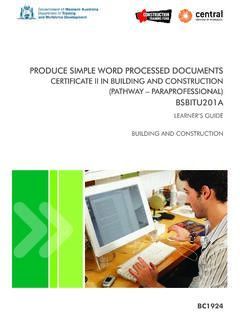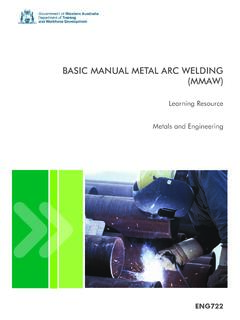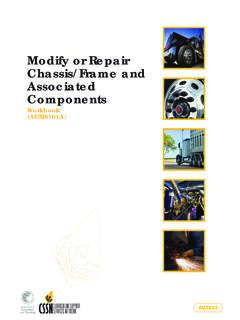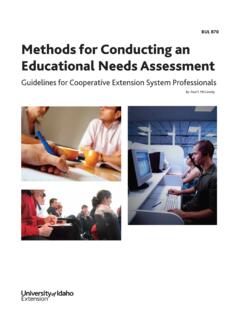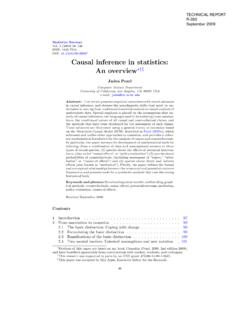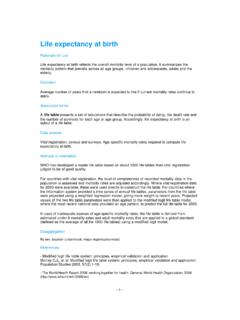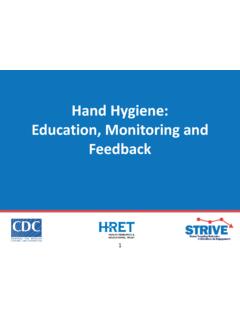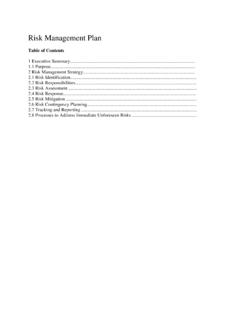Transcription of Assessment in the VET sector - dtwd.wa.gov.au
1 Assessment in the VET sector 2nd edition 2016. Building the workforce to meet the economic and community needs of Western Australia First published 2015. 2nd edition 2016. DISCLAIMER. While every effort is made to maintain their accuracy, currency and usefulness, these publications are edited only once a year and may not remain current with changes implemented at state and federal level. The publications are accurate as at the date of publication shown on this page. If in doubt, please check the many websites referenced within each publication. TITLE: Assessment in the VET sector Department of Training and Workforce Development, Western Australia, 2016. Reproduction of this work in whole or part for educational purposes within an educational institution and on the condition that it is not offered for sale is permitted by the Department of Training and Workforce Development.
2 Department of Training and Workforce Development 1 Prospect Place, WEST PERTH WA 6005. E: W: Assessment in the VET sector Contents 5. Chapter 1 Developing strategies for learning and 7. What is competency based Assessment ?.. 9. The principles of 11. Chapter 2 Designing Assessment 13. Four steps to quality Assessment 13. Chapter 3 Clustering units for 43. Why should units of competency be clustered?.. 43. Chapter 4 Reasonable adjustment and inclusive 59. 59. Reasonable adjustment 59. The purpose of reasonable 61. The kinds of reasonable adjustment that can be 62. Preparing to make reasonable 69. Chapter 5 Recognition of prior 75. 75. RPL Assessment 75. General principles for 77. A task based model for 79. Chapter 6 Assessor 83. 83. Is the demonstration of equivalence the same as RPL?.. 84. Industry 84. Chapter 7 Validation and 87. 87. The purpose of an improvement 87.
3 Systematically collecting and analysing 88. Demonstrating 89. Aspects of Assessment to be 89. Quality standards in 91. Stakeholders in quality 93. Strategies for 93. VET (WA) Ministerial Corporation 2016 3. Assessment in the VET sector Recording the outcomes of improvement 96. Gathering the evidence for continuous 97. Government 102. Regulatory 102. Appendix 1 Useful links and 103. 103. Websites providing ongoing information relevant to competency based 103. Other publications and 104. Organisations providing information or assistance on 105. Appendix 2 107. 4 VET (WA) Ministerial Corporation 2016. Introduction The purpose of this publication is to provide practitioners and other stakeholders in the vocational education and training sector in Western Australia with information on the processes and practices involved in an Assessment system.
4 This information has not been referenced to specific regulatory standards; however, it is based on current standards and reflects good practice. The information applies to training package qualifications and accredited courses with a vocational outcome. While the regulatory standards do not specify any particular documentation for Assessment systems, the documents in this publication are examples that a registered training organisation can consider and adopt as required. This publication consists of the following: an introduction to developing strategies for Assessment and the concepts around competency based Assessment ;. a guide to the development of Assessment tools;. information about how to cluster units of competency for Assessment ;. a guide to planning and conducting Assessment process for employers and assessors involved in competency based Assessment .
5 How to adjust Assessment processes and tools for inclusive practice;. a guide to conducting RPL;. information about assessor competencies;. a guide to validation and evaluation of Assessment systems and processes;. a list of resources for assessors, including websites, organisations and materials on Assessment ; and a glossary of terms. A series of exemplar materials and templates for adaptation and use by trainers/assessors is provided throughout. VET (WA) Ministerial Corporation 2016 5. Assessment in the VET sector Chapter 1. Developing strategies for learning and Assessment Registered training organisations are tasked with developing learning and Assessment strategies, processes and materials that meet the needs of their clients and maximise outcomes. This can include learning and Assessment that lead to the award of a statement of attainment or a full qualification.
6 In order to meet clients' needs and maximise outcomes, RTOs need to develop processes and products that focus on the quality of the learning and Assessment experience. It is well established in research that effective strategies involve learners: making sense of new knowledge and skills, and developing understanding rather than simply learning sets of facts and information to be reproduced when required;. looking for what is significant, such as key concepts and principles, relationships between ideas, and lines of reasoning;. relating new ideas to previous knowledge and experiences;. finding the link between conceptual knowledge and real world applications; and employing higher order thinking skills through examining issues, clarifying problems, producing their own ideas and thinking critically. The learning and Assessment strategy provides a clear picture of the learning and Assessment delivered to the learner and how and when this will be achieved.
7 It is the blueprint for the delivery of the qualification or skill set. To be able to develop an effective strategy, the RTO needs to consult and consider the following information when developing a learning and Assessment strategy. A training package is endorsed by the Skills Service Organisation or its delegate in accordance with the Standards for Training Packages. The endorsed components of a training package are: units of competency;. Assessment requirements (associated with each unit of competency);. qualifications; and credit arrangements. The endorsed components form part of the requirements that an RTO must meet under these Standards. A training package also consists of a non endorsed, quality assured companion volume which contains industry advice to RTOs on different aspects of implementation. The companion volumes can be found on the SSO websites.
8 6 VET (WA) Ministerial Corporation 2016. Training package qualifications are designed to allow customisation to meet the needs of a range of learners. This is achieved by choosing a combination of units of competency that meet the needs of both the learner and the industry, as well as the packaging rules for the qualification. The RTO will consult with industry and potential learners to discuss and decide which units to include in the qualification. The following factors may influence the choice of units: the type of work undertaken in the workplace;. the availability of machinery/equipment and staff to support the learning and Assessment ;. any conditions imposed by licensing authorities or regulatory requirements;. any competency already held by the learner; and any seasonal or shift requirements that may restrict the opportunity for learning and Assessment .
9 This list is not definitive and the RTO's discussions with industry and the learner will uncover other opportunities or restrictions that may need to be considered in deciding the qualification packaging. RTOs need to be aware of any delivery requirements specified in legislation or regulations. Any concerns that an RTO may have in this regard should be discussed with the appropriate governing body. Once a decision has been made about the units of competency to be included in the qualification, the delivery and Assessment schedule and methodologies can be determined. The following factors will influence these decisions: any prerequisites stipulated by the training package;. the most logical order for delivery and Assessment of the units of competency (or clusters of units);. the integration of on the job and off the job training (if appropriate).
10 The qualifications and experience of the staff delivering or supporting learning and conducting Assessment ;. the accessibility and availability of any resources needed, including equipment, machinery and supervisory staff;. the requirement for simulation (if any);. the arrangements for access to workplaces (if required);. the most appropriate methodology for delivery and Assessment , both on and off the job, subject to legislation or regulations which may include national recognition or recognition of prior learning; any special arrangements for training and/or Assessment that need to be made for learners with special needs; and the expected duration of the qualification, including determining the amount of training the learners require. VET (WA) Ministerial Corporation 2016 7. Assessment in the VET sector Decisions relating to these factors should be recorded in the strategy, or the strategy should refer the reader to this information if it is recorded in other supporting documents.
